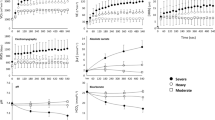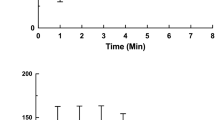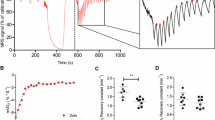Abstract
Single muscle fibre metabolites and pulmonary oxygen uptake (V̇O2) were measured during moderate and intense, sub-maximal exercise to test the hypothesis that additional fibre recruitment is associated with the slow component of V̇O2. Seven healthy, male subjects performed 20 min moderate (MOD, ~50% of V̇O2,max) and intense (INT, ~80% V̇O2,max) cycling at 70 rpm. Glycogen content decreased significantly in type I and IIa fibres during INT, but only in type I fibres during MOD. During INT, creatine phosphate (CP) content decreased significantly both in types I and II fibres in the first 3 min (ΔCP: 16.0±2.7 and 16.8±4.7 mmol kg−1 d.w., respectively) and in the next 3 min (ΔCP: 16.2±4.9 and 25.7±6.7 mmol kg−1 d.w., respectively) with no further change from 6–20 min. CP content was below the pre-exercise level (mean−1 SD) in 11, 37, 70 and 74% of the type I fibres after 0, 3, 6 and 20 min of INT, respectively, and in 13, 45, 83 and 74% of the type II fibres. During INT, V̇O2 increased significantly by 6±1 and 4±1% in the periods 3–6 and 6–20 min, respectively (ΔV̇O2,(6−3min): 0.14±0.02 l min−1), whereas V̇O2 was unchanged from 3 to 20 min of MOD. Exponential fitting revealed a slow component of V̇O2 during INT that appeared after ~2.6 min and amounted to 0.24 l min−1. The present study demonstrates that additional type I and II fibres are recruited with time during intense sub-maximal exercise in temporal association with a significant slow component of V̇O2.





Similar content being viewed by others
References
Aaron EA, Seow KC, Johnson BD, Dempsey JA (1992) Oxygen cost of exercise hyperpnea: implications for performance. J Appl Physiol 72:1818–1825
Bangsbo J (1998) Quantification of anaerobic energy production during intense exercise. Med Sci Sports Exerc 30:47–52
Bangsbo J (2000) Muscle oxygen uptake in humans at onset of and during intense exercise. Acta Physiol Scand 168:457–464
Bangsbo J, Graham T, Johansen L, Strange S, Christensen C, Saltin B (1992) Elevated muscle acidity and energy production during exhaustive exercise in humans. Am J Physiol 263:R891–R899
Bangsbo J, Krustrup P, González-Alonso J, Saltin B (2001) ATP production and efficiency of human skeletal muscle during intense exercise: effect of previous exercise. Am J Physiol 280:E956–E964
Bangsbo J, Madsen K, Kiens B, Richter EA (1996) Effect of muscle acidity on muscle metabolism and fatigue during intense exercise in man. J Physiol (Lond) 495:587–596
Barclay CJ (1996) Mechanical efficiency and fatigue of fast and slow muscles of the mouse. J Physiol (Lond) 497:781–794
Barstow TJ, Molé P (1991) Linear and non-linear characteristics of oxygen uptake kinetics during heavy exercise. J Appl Physiol 71:2099–2106
Barstow TJ, Casaburi R, Wasserman K (1993) O2 uptake kinetics and the O2 deficit as related to exercise intensity and blood lactate. J Appl Physiol 75:755–762
Barstow TJ, Jones AM, Nguyen PH, Casaburi R (1996) Influence of muscle fiber type and pedal frequency on oxygen uptake kinetics of heavy exercise. J Appl Physiol 81:1624–1650
Bergström J (1962) Muscle electrolytes in man. Scand J Clin Lab Invest (Suppl) 68:1–101
Bigland-Ritchie B, Donovan EF, Roussos CS (1981) Conduction velocity and EMG power spectrum changes in fatigue of sustained maximal efforts. J Appl Physiol 51:1300–1305
Brooke MH, Kaiser KK (1970) Three myosine adenosine triphosphatase” systems: the nature of their pH lability and sulfhydryl dependence. J Histochem Cytochem 18:670–672
Burnley M, Doust JH, Ball D, Jones AM (2002) Effects of prior exercise on V̇O2 kinetics during heavy exercise are related to changes in muscle activity. J Appl Physiol 93:167–174
Cooke R, Franks K, Luciani GB, Pate E (1988) The inhibition of rabbit skeletal muscle contraction by hydrogen ions and phosphate. J Physiol (Lond) 395:77–97
Coyle EF, Sidossis LS, Horowitz JF, Beltz JD (1992) Cycling efficiency is related to percentage of Type I muscle fibres. Med Sci Sports Exerc 24:782–788
Crow MT, Kushmerick MJ (1982) Chemical energetics of slow- and fast-twitch muscles of the mouse. J Gen Physiol 79:147–166
Di Prampero PE, Boutellier U, Marguerat A (1988) Efficiency of work performance and contraction velocity in isotonic tetani of frog sartorius. Pflugers Arch 412:455–461
Ericson MO, Nisell R, Arborelius UP, Ekholm J (1985) Muscular activity during ergometer cycling. Scand J Rehabil Med 17:53–61
Gaesser GA, Poole DC (1996) The slow component of oxygen uptake kinetics in humans. Exerc Sport Sci Rev 24:35–71
Gaesser GA, Ward SA, Baum VC, Whipp BJ (1994) Effects of infused epinephrine on slow phase O2 uptake kinetics during heavy exercise in humans. J Appl Physiol 77:2413–2419
Gollnick PD, Piehl K, Saltin B (1974) Selective glycogen depletion pattern in human skeletal muscle fibres after exercise of varying intensity and at varying pedalling rates. J Physiol (Lond) 241:45–57
He Z-H, Bottinelli R, Pellegrino MA, Ferenczi MA, Reggiani C (2000) ATP consumption and efficiency of human single muscle fibers with different myosin isoform composition. Biophys J 79:945–961
Horowitz JF, Sidossis LS, Coyle EF (1994) High efficiency of type I muscle fibers improves performance. Int J Sports Med 15:152–157
Houtman CJ, Stegeman DF, Van Dijk JP, Zwarts MJ (2003) Changes in muscle fiber conduction velocity indicate recruitment of distinct motor unit populations. J Appl Physiol 95:1045–1054
Jones AM, Carter H, Doust JH (1999) A disproportionate increase in V̇O2 coincident with lactate threshold during treadmill exercise. Med Sci Sports Exerc 31:1299–1306
Kitamura K, Jorgensen CR, Gobel FL, Taylor HL, Wang Y (1972) Hemodynamic correlates of myocardial oxygen consumption during upright exercise. J Appl Physiol 32:516–522
Koga S, Shiojiri T, Kondo N, Barstow TJ (1997) Effect of increased muscle temperature on oxygen uptake kinetics during exercise. J Appl Physiol 83:1333–1338
Koppo K, Jones AM, Vanden Bossche L, Bouckaert J (2002) Effect of prior exercise on V̇O2 slow component is not related to muscle temperature. Med Sci Sports Exerc 34:1600–1604
Krustrup P, González-Alonso J, Quistorff B, Bangsbo J (2001) Muscle heat production and anaerobic energy turnover during repeated intense dynamic exercise in humans. J Physiol (Lond) 536:947–956
Krustrup P, Ferguson RA, Kjaer M, Bangsbo J (2003) ATP and heat production in human skeletal muscle during dynamic exercise: higher efficiency of anaerobic than aerobic ATP resynthesis. J Physiol (Lond) 549:255–269
Kuznetsov AV, Tiivel T, Sikk P, Kaambre T, Kay L, Daneshrad Z, Rossi A, Kadaja L, Peet N, Seppet E, Saks VA (1996) Striking differences between the kinetics of regulation of respiration by ADP in slow-twitch and fast-twitch muscles in vivo. Eur J Biochem 241:909–915
Lowry OH, Passonneau JV (1972) A flexible system of enzymatic analysis. Academic Press, New York
Medbø JI, Tabata I (1989) Relative importance of aerobic and anaerobic energy release during short-lasting exhausting bicycle exercise. J Appl Physiol 67:1881–1886
Moritani T, Sherman WM, Shibata M, Matsumoto T, Shinohara M (1992) Oxygen availability and motor unit activity in humans. Eur J Appl Physiol 64:552–556
Poole DC, Schaffartzik W, Knight DR, Derion T, Kennedy B, Guy HJ, Prediletto R, Wagner PD (1991) Contribution of exercising legs to the slow component of oxygen uptake kinetics in humans. J Appl Physiol 71:1245–1260
Poole DC, Gladden LB, Kurdak S, Hogan MC (1994) l-(+)-Lactate infusion into working dog gastrocnemius: no evidence lactate per se mediates V̇O2 slow component. J Appl Physiol 76:787–792
Pringle JS, Doust JH, Carter H, Tolfrey K, Jones AM (2003) Effect of pedal rate on primary and slow-component oxygen uptake responses during heavy-cycle exercise. J Appl Physiol. 94:1501–1507
Pringle JS, Doust JH, Carter H, Tolfrey K, Campbell IT, Jones AM (2003) Oxygen uptake kinetics during moderate, heavy and severe intensity ‘sub-maximal’ exercise in humans: the influence of muscle fiber type and capillarisation. Eur J Appl Physiol 89:289–300
Rasmussen UF, Krustrup P, Bangsbo J, Rasmussen HN (2001) Effect of exhaustive bicycle exercise upon the metabolism of isolated human skeletal muscle mitochondria. Pflugers Arch 443:180–187
Rossiter HB, Ward SA, Kowalchuk JM, Howe FA, Griffiths JR, Whipp BJ (2002) Dynamic asymmetry of phosphocreatine concentration and O2 uptake between the on- and off-transients of moderate and high-intensity exercise in humans. J Physiol (Lond) 541:991–1002
Roston WL, Whipp BJ, Davis JA, Cunningham DA, Effros RM, Wasserman K (1987) Oxygen uptake kinetics and lactate concentration during exercise in humans. Am Rev Respir Dis 135:1080–1084
Sahlin K, Söderlund K, Tonkonogi M, Hirakoba K (1997) Phosphocreatine content in single fibres of human muscle after sustained submaximal exercise. Am J Physiol 273:C172–C178
Sargeant AJ (1987) Effect of muscle temperature on leg extension force and short-term power output in humans. Eur J Appl Physiol 56:693–698
Saunders MJ, Evans EM, Arngrimsson SA, Allison JD, Warren GL, Cureton KJ (2000) Muscle activation and the slow component rise in oxygen uptake during cycling. Med Sci Sports Exerc 32:2040–2045
Scheuermann BW, Hoelting BD, Noble ML, Barstow TJ (2001) The slow component O2 uptake is not accompanied by changes in muscle EMG during repeated bouts of heavy exercise in humans. J Physiol (Lond) 531:245–256
Söderlund K, Hultman E (1991) ATP and phosphocreatine changes in single human muscle fibres following intense electrical stimulation. Am J Physiol 261:E737–E741
Tonkonogi M, Harris B, Sahlin K (1998) Mitochondrial oxidative function in human saponin-skinned muscle fibres: effects of prolonged exercise. J Physiol (Lond) 510:279–286
Tordi N, Perrey S, Harvey A, Hughson RL (2003) Oxygen uptake kinetics during two bouts of heavy cycling separated by fatiguing sprint exercise in humans. J Appl Physiol 94:533–541
Viitasalo JT, Luhtanen P, Rahkila P, Rusko H (1985) Electromyographic activity related to aerobic and anaerobic threshold in ergometer bicycling. Acta Physiol Scand 124:287–293
Völlestad NK, Blom PC (1985) Effect of varying exercise intensity on glycogen depletion in human muscle fibres. Acta Physiol Scand 125:395–405
Westerblad H, Bruton JD, Lannergren J (1997) The effect of intracellular pH on contractile function of intact, single fibres of mouse muscle declines with increasing temperature. J Physiol (Lond) 500:193–204
Whipp BJ, Wasserman K (1972) Oxygen uptake for various intensities of constant-load exercise. J Appl Physiol 33:351–356
Whipp BJ, Wasserman K (1986) Effect of anaerobiosis on the kinetics of O2 uptake during exercise. Fed Proc 45:2942–2947
Wibom R, Söderlund K, Lundin A, Hultman E (1991) A luminometric method for determination of ATP and phosphocreatine in single human skeletal muscle fibres. J Biolumin Chemilumin 6:123–129
Willis WT, Jackman MR (1994) Mitochondrial function during heavy exercise. Med Sci Sports Exerc 26:1347–1354
Womack CJ, Davis SE, Blumer JL, Barrett E, Weltman AL, Gaesser GA (1995) Slow component of O2 uptake during heavy exercise: adaptations to endurance training. J Appl Physiol 79:838–845
Zoladz JA, Rademaker AC, Sargeant AJ (1995) Non-linear relationship between O2 uptake and power output at high intensities of exercise in humans. J Physiol (Lond) 488:211–217
Acknowledgements
We thank the enthusiastic volunteers participating in the study. We also thank Ingelise Kring, Merete Vannby, Winnie Taagerup and Berit Sjöberg for excellent technical assistance. Furthermore, the valuable work with mathematical modelling of V̇O2 curves by Dr. Ansgar Sørensen is appreciated. The study was supported by a grant from The Danish National Research Foundation (504-14). In addition, support was obtained from The Sports Research Council (Idraettens Forskningsråd).
Author information
Authors and Affiliations
Corresponding author
Rights and permissions
About this article
Cite this article
Krustrup, P., Söderlund, K., Mohr, M. et al. The slow component of oxygen uptake during intense, sub-maximal exercise in man is associated with additional fibre recruitment. Pflugers Arch - Eur J Physiol 447, 855–866 (2004). https://doi.org/10.1007/s00424-003-1203-z
Received:
Accepted:
Published:
Issue Date:
DOI: https://doi.org/10.1007/s00424-003-1203-z




